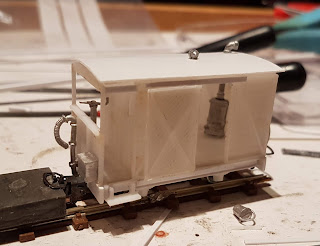Back on the island the last couple of weeks have seen a few new arrivals. Firstly, a Bachmann Rheneas arrived, a nice sweet runner but a bit on the orange side and with a stupid face. The plan is to convert it to either a proper model of Dolgoch or some sort of Isle of Stoner version, possibly cabless. Either way I need an NP Dolcoghification kit which is currently out of stock so the decision can be postponed. I've put it back in its box for now but I might start work taking it to bits and stripping the paint off it in preparation.
Nice, but too orange.
The kit makes it possible to build with the doors open so I decided that one open door was a good idea.
While looking for the whitemetal brake pipes etc I found a casting of a stove from a signal box interior (Wills?) kit. It seemed like a good excuse to add it to the van's inside.
I made a bit of a bodge putting it together but it's come out OK in the end and has entered service. Known by IoSR guards as 'the winter van' on account of how cosy the stove keeps it.
Here it is, waiting for a run down the line.
Another random purchase was one of the newly re engineered KATO 11 109 chassis which replaced the venerable 11 103s. It finally arrived and I wondered what to do with it. On test it ran very smoothly and slowly in exactly the way the old ones didn't. I was never a big fan of them but I do have a couple of things which have them as motive power which will now need to be swapped out and become useful vehicles. Anyway, I didn't want to just do a swap for an old one so I had a rummage on Shapeways and found a rather nicely proportioned Tom Bell designed, two ended railcar.
The print as it arrived just with the new chassis clipped in place
Never one to build things as intended I set about mucking about with the body. It has a rather textural surface as I opted for the cheaper (although still rather too pricey) white plastic version. It has the advantage of being less fragile and easier to cut and drill but the disadvantage of a surface texture you can't easily flatten. I added some styrene H beams underneath and few other styrene parts to make the proportions more pleasing to my eye.
I wanted to fit an interior which I constructed to be able to be poked through the hole on the floor that the chassis fits in but I wasn't looking forward to finishing the inside through this aperture.
I thought about cutting the roof off but couldn't see how I could do it neatly enough to put it back on with it looking awful. Then it occurred that I could leave the edge of the roof intact and then put a thin covering on once the interior was finished. So out with the dremel and off with the roof. Then a suggestion was made in jest that it could be a convertible. I loved that idea and so tidied up the edges of the hole and got on with painting and building the insides.
The inside on the outside
With a sleepless night or two and continuing lockdown I finished the painting and detailing. The canvas roof is a piece of bog roll cut to shape and wound round a length of brass rod, stiffened with superglue and then painted. It's a similar idea to how I've made canvas cab backs for a couple of open cabbed steam locos. I found the Dennis nameplates from the recent Narrow Planet Beyer Peacock build and it occured to me that it was an appropriate name for a railbus.
I'm rather pleased with the result and it has joined the fleet of steam and ic powered railcars and tram type things.
A gathering of all of the passenger trams and railcars. In the platform road (L to R) are the small steam tram, 'Lady Susan' the big steam tram, 'Dennis', 'Herman' and 'Brigitte' and her O&K coach. In the loop line are 'Queenie' and 'Nursie'. 'Nursie is one of my oldest surviving vehicles and runs on a Bachmann 0-6-0 diesel.


























